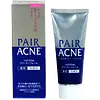What's inside
What's inside
 Key Ingredients
Key Ingredients

No key ingredients
 Benefits
Benefits

 Concerns
Concerns

 Ingredients Side-by-side
Ingredients Side-by-side

Dipotassium Glycyrrhizate
HumectantO-Cymen-5-Ol
AntimicrobialMyristic Acid
CleansingGlycerin
HumectantDipropylene Glycol
HumectantCoconut Oil Decyl Esters
Skin ConditioningPotassium Hydroxide
BufferingPalmitic Acid
EmollientN-Lauryl Diethanolamine
Sorbitol
HumectantPEG-150
HumectantGlycol Distearate
EmollientParfum
MaskingEDTA
Butylene Glycol
HumectantTocopherol
AntioxidantMagnesium Phosphate
StabilisingGlycine Soja Extract
Skin ConditioningSodium Paraben
PreservativeDipotassium Glycyrrhizate, O-Cymen-5-Ol, Myristic Acid, Glycerin, Dipropylene Glycol, Coconut Oil Decyl Esters, Potassium Hydroxide, Palmitic Acid, N-Lauryl Diethanolamine, Sorbitol, PEG-150, Glycol Distearate, Parfum, EDTA, Butylene Glycol, Tocopherol, Magnesium Phosphate, Glycine Soja Extract, Sodium Paraben
 Reviews
Reviews

Ingredients Explained
These ingredients are found in both products.
Ingredients higher up in an ingredient list are typically present in a larger amount.
Glycerin is already naturally found in your skin. It helps moisturize and protect your skin.
A study from 2016 found glycerin to be more effective as a humectant than AHAs and hyaluronic acid.
As a humectant, it helps the skin stay hydrated by pulling moisture to your skin. The low molecular weight of glycerin allows it to pull moisture into the deeper layers of your skin.
Hydrated skin improves your skin barrier; Your skin barrier helps protect against irritants and bacteria.
Glycerin has also been found to have antimicrobial and antiviral properties. Due to these properties, glycerin is often used in wound and burn treatments.
In cosmetics, glycerin is usually derived from plants such as soybean or palm. However, it can also be sourced from animals, such as tallow or animal fat.
This ingredient is organic, colorless, odorless, and non-toxic.
Glycerin is the name for this ingredient in American English. British English uses Glycerol/Glycerine.
Learn more about Glycerin